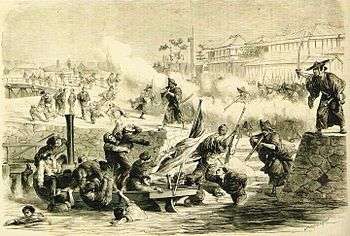Sakai incident

The Sakai incident (堺事件 Sakai Jiken) was the killing of 11 French sailors from the French corvette Dupleix in the port of Sakai near Osaka, Japan in 1868.
On March 8, 1868, a skiff sent to Sakai was attacked by samurai of the Tosa clan; 11 sailors and Midshipman Guillou were killed (a monument in Kobe is now erected to their memory).[1] At the time, the port of Sakai was open to foreign ships, and the Tosa troops were in charge of policing the city.
The French captain Dupetit Thouars protested so strongly that an indemnity of 150,000 dollars was agreed upon, and 29 troop members who admitted firing shots as well as the troop leaders were sentenced to death by seppuku at Myōkoku-ji. However, fearing that executing all troop members would inflame anti foreign sentiment which were already rife in Japan, the number were reduced to 20 by a draw. However, at the execution, the indignant samurai cut open their abdomens and allow their intestines to flow, to shock the French who were observing the execution. After 11 performed their own execution, which matched the number of French killed, the French captain requested a pardon, sparing nine of the samurai to banishment instead. Quoting the Moniteur, the London Morning Post described the executions:
- On the 15th [a Japanese] high functionary brought a written reply from his Government conceding all the satisfaction required. On the following day Captain du Petit-Thouars, commander of the Dupleix, landed at Sakai to witness the execution of two officers, a subaltern, and 17 Japanese soldiers, condemned to death as the principal authors of the aggression. The two chiefs were the first put to death, after which nine others perished successively. Captain du Petit-Thouars then seeing that the Japanese Government was decided on carrying out its engagements to the end, and ceding to a feeling of humanity, stayed the execution, declaring that he considered the reparation sufficient, and that he proposed to ask the Minister of France to intercede for a commutation of punishment in favour of the other condemned.[2]
This incident was dramatised in a short story, Sakai Jiken, by Mori Ōgai.
See also
Notes
- ↑ The monument can be found at just west of the southern entrance to the Sannomiya shrine.
- ↑ "1868: Eleven samurai, for the Sakai Incident". Retrieved 23 March 2016.